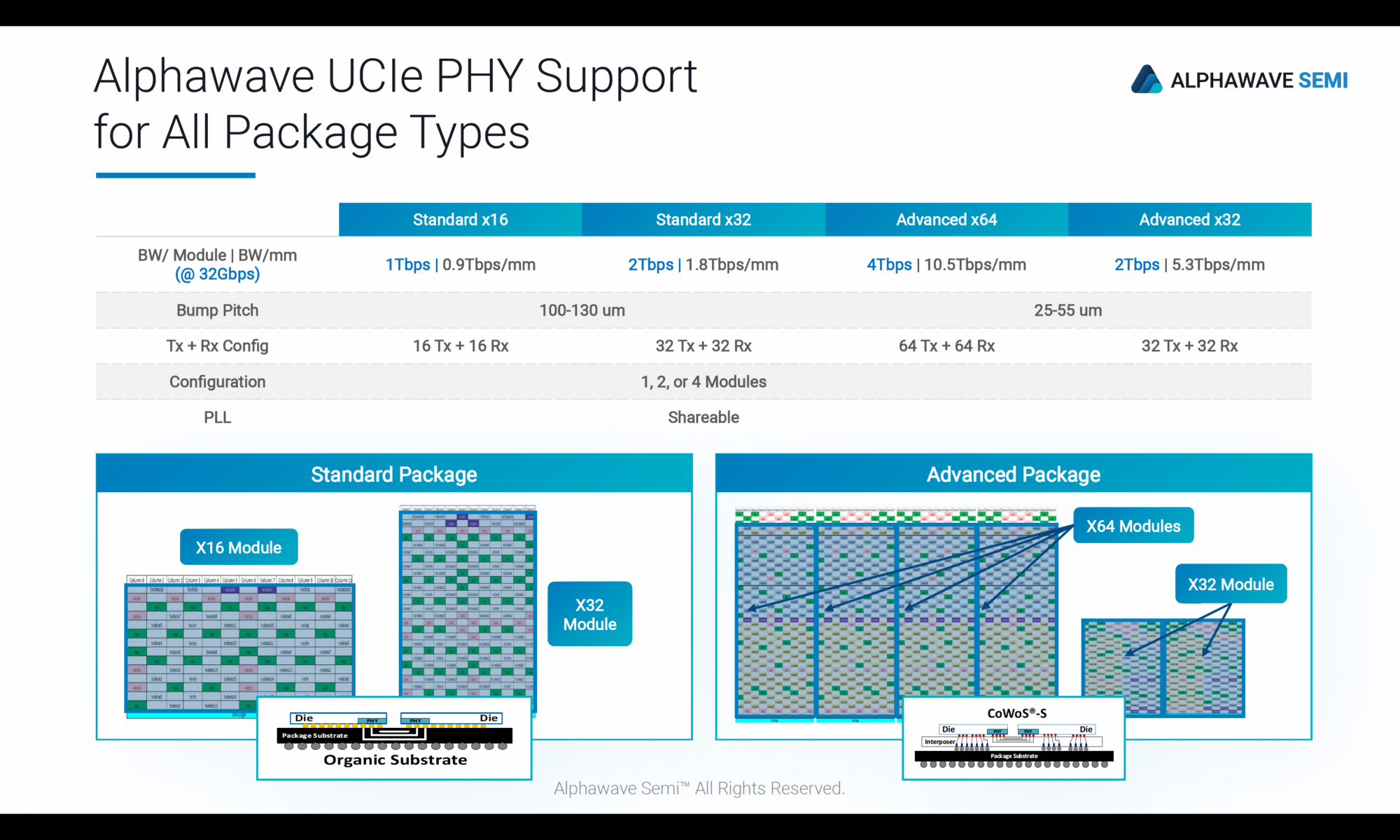Artificial Intelligence (AI) continues to revolutionize industries, from healthcare and finance to automotive and manufacturing. AI applications, such as machine learning, deep learning, and neural networks, rely on vast amounts of data for training, inference, and decision-making processes. As AI algorithms become more sophisticated and datasets grow larger, the demand for computational power and data throughput is escalating rapidly. With the proliferation of data-intensive tasks, AI systems require escalating bandwidth to support seamless communication between diverse components, including CPUs, GPUs, accelerators, memory modules, and specialized modules dedicated to AI tasks. To meet these demands, AI systems require robust connectivity solutions that can provide high bandwidth, low latency, scalability, and energy efficiency.
The Role of UCIe and Chiplet Interfaces
With disaggregation of resources for optimizing system architectures, semiconductor design and package optimizations are the future of advanced compute semiconductors. Chiplet interfaces offer a promising solution to the escalating bandwidth needs in AI systems by providing efficient connectivity between disparate components. For example, chiplet interfaces enable disaggregated architectures with cloud computing infrastructure, where CPU, GPU, and memory chiplets are interconnected via high-speed interfaces, allowing for efficient resource allocation and utilization in AI training and inference tasks. In autonomous vehicles, chiplet interfaces enable seamless integration of AI accelerators, sensor processing units, and communication modules, supporting real-time decision-making and sensor fusion tasks. In healthcare, chiplet interfaces facilitate the integration of AI accelerators with medical imaging devices, enabling faster image processing and analysis for diagnostic purposes.
UCIe, in particular, defines a standardized framework for chiplet-based interconnectivity, enabling seamless integration and communication between chiplets from different vendors.
Benefits of Standardized Interfaces for AI System Connectivity
High Bandwidth: UCIe and chiplet interfaces support high-speed data transfer rates, allowing for rapid exchange of information between chiplets. This high bandwidth is essential for handling large datasets and accelerating AI workloads.
Low Latency: With reduced signal propagation delays and optimized routing algorithms, UCIe and chiplet interfaces minimize latency, ensuring timely processing of data and real-time responsiveness in AI applications.
Scalability: AI systems often require flexible and scalable architectures to accommodate increasing computational demands. UCIe and chiplet interfaces enable modular designs, where chiplets can be added or removed dynamically, allowing for seamless scalability as workload requirements evolve.
Energy Efficiency: UCIe and chiplet interfaces are designed to optimize energy efficiency by minimizing power consumption during data transfer and communication. This is particularly important for AI systems deployed in edge computing and IoT devices with limited power budgets.
Addressing AI System Connectivity Needs
At the IPSoC 2024 conference last month, Sue Hung Fung , Principal Product Line Manager
And Soni Kapoor, Principal Product Marketing Manager, both from Alphawave Semi, presented the company’s offerings addressing these needs.
Alphawave Semi’s Complete UCIe Solution
Leveraging silicon-proven analog IP, the UCIe solution boasts a robust Physical Layer-Electrical PHY (Analog Front End) responsible for ensuring reliable and high-speed data transmission between chiplets. This includes critical functions such as clocking, link training, and sideband signal management, all integrated seamlessly to enable efficient communication across the UCIe interconnect. Additionally, the UCIe solution features a Die-to-Die Adapter component, facilitating link state management and parameter negotiations crucial for chiplet interoperability, while implementing error detection and correction mechanisms to ensure robust data transmission. With support for industry-standard protocols like PCIe and CXL, as well as a Streaming Protocol for enhanced system design flexibility, Alphawave Semi’s UCIe solution offers a comprehensive platform for interoperability testing, ensuring seamless integration into diverse computing systems.
Alphawave Semi’s UCIe Physical Layer (PHY) is designed to accommodate various package types, including standard x16 and x32 configurations commonly found in servers, workstations, and high-performance computing platforms, as well as advanced x32 and x64 packages ideal for data centers and AI accelerators. This support for multiple package types not only ensures seamless integration into existing and future computing systems but also provides system designers with the flexibility to tailor configurations to specific application needs. Leveraging advanced signaling and interface technologies, the UCIe PHY delivers high-speed data transmission and low-latency communication, ensuring optimal performance for demanding workloads.

![]()
Summary
As AI computational demands are escalating, chiplets play a crucial role in enabling efficient and scalable solutions. Alphawave Semi’s D2D IP Subsystem Solutions, tailored for chiplet communication, empower AI systems to achieve unprecedented levels of performance and energy efficiency. Alphawave Semi’s comprehensive solutions and chiplet architectures cater to the evolving demands of System-in-Packages (SiPs). In addition to its UCIe interface solutions, Alphawave Semi offers many other high-performance connectivity silicon IP. To learn more, visit the company’s product page.
![]()
Also Read:
Alphawave Semi Bridges from Theory to Reality in Chiplet-Based AI
The Data Crisis is Unfolding – Are We Ready?
Accelerate AI Performance with 9G+ HBM3 System Solutions
Share this post via:






Comments
There are no comments yet.
You must register or log in to view/post comments.